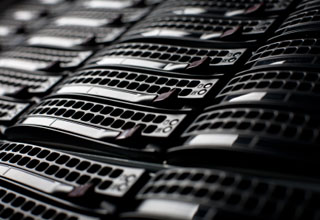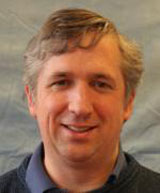The secret superhero on campus
Interview with Professor Mark Rodger, Director of the Centre for Scientific Computing
Published in 2011

There’s a secret superhero on campus. It is the size of six, six-feet-tall filing cabinets and currently resides in the physical sciences building, the only place on campus with the necessary power and cooling facilities to keep it happy and working effectively. It’s not a bird, or a plane … it’s the University’s super computer, which touched down at Warwick in 2011.
Whilst an average laptop has only a few cores (its processing function capable of making calculations), Warwick’s super computer has 3,300. This enables scientists and researchers to run large, complicated calculations alongside each other.
"When it works, it’s like an army marching in step..."
Professor Mark Rodger, Director of the Centre for Scientific Computing (CSC), explains. “When I think about doing a big calculation I can think about breaking it up into little bits, getting each core to do one of the bits, and then putting them back together again. When it works, it’s like an army marching in step.”
An example of the use of super computers in academia is in the world of climate modelling. To calculate predictions of global warming, researchers can divide a model of the atmosphere into ‘cubes‘ and layers of cubes, with each core modelling what’s going on in one cube. As each core can communicate with the others, the calculations can take account of whether one core, for example, has heated up or cooled down and the impact this has on its neighbours.
The University has plenty of projects lined up to keep the super computer busy. Prof Rodger points out that the super computer is invaluable to research in science and material properties. He personally is using an atomistic model to research how biominerals form and has recently published his work on eggshell development. For the research he used a super computer. “Having lots of processors helps. I can look at 100,000 atoms and not just a few. It’s in the realms of nanoscience.” His work is part of a larger initiative that involves people in the chemistry and physics departments together with five other UK Universities and one in Copenhagen. The group is researching bone growth and coral formation to try to understands how clever formations can be made.
Departments across the university can use the super computer. There’s a fair use scheduling system in place with allocation dependant on the resources needed and how many cores of the super computer researchers want to use for their project. However if a department wants to use most of the processors together then they are recommended to book time on the super computer. Prof Rodgers likens it to a car park: “if you want to fill half the spaces in a car park it might be hard to find spaces together but two or three cars may fit in quite easily”.
The Super Computer...
|
The University’s previous super computer, daintily named Francesca, will still be available for some research. Scientific computing is a rapidly-growing field with development advances meaning that even the latest technology quickly becomes outdated. Francesca herself is less than ten years old and was in the world’s top 100 super computers when she was new. To get a sense of the fast pace of development in computer science, note that Warwick’s current super computer is four times the size of Francesca.
Half of the £1.3 million cost of the super computer came from the University with the other half provided by a grant to support the MHD (magnetohydrodynamics) Consortium. This UK-based consortium project created three super computers to advance research in the flow of magnetic fluids. Professor Tony Arber in the Department of Physics is working on solar MHD simulations and will use the super computer for his research into what goes on within the sun. He is focusing on the magnetic interactions between particles and the flow of magnetic fluids.
Robert Kerr, who works in the CSC and is also a Professor in the School of Engineering and Department of Mathematics, is researching the turbulence of fluids. He uses a super computer to model turbulence as part of his work into minimising the noise in jet engines. Other fluid flow projects the super computer can be used for include the best models of blood flow through a body and the flow of air through the lungs.
IBM supplied the parts for the super computer and OCF put them together to make and test the finished product. The current trend when it comes to commissioning new super computers in higher education is a collective approach. Prof Rodger points out that although Warwick’s super computer has a huge processing capacity it doesn’t match the power of the research councils’ super computers, such as the Engineering and Physical Sciences Research Council (EPSRC)’s Hector, which has 10,000 cores. Prof Rodger says that for larger projects “we use the super computer at Warwick to make sure the research will work on the even bigger computer”.
 Professor Mark Rodger is Director of the Centre for Scientific Computing (CSC) at the University of Warwick and Professor in Molecular Simulation in the Department of Chemistry. His research is on atomistic simulation of liquids, crystals and interfaces, predominantly using statistical mechanics methods including molecular dynamics. He took his BSc and PhD degrees in Sydney, Australia. Prof Rodger has previously used the University’s super computer to crack a problem in egg shell formation.
Professor Mark Rodger is Director of the Centre for Scientific Computing (CSC) at the University of Warwick and Professor in Molecular Simulation in the Department of Chemistry. His research is on atomistic simulation of liquids, crystals and interfaces, predominantly using statistical mechanics methods including molecular dynamics. He took his BSc and PhD degrees in Sydney, Australia. Prof Rodger has previously used the University’s super computer to crack a problem in egg shell formation.
